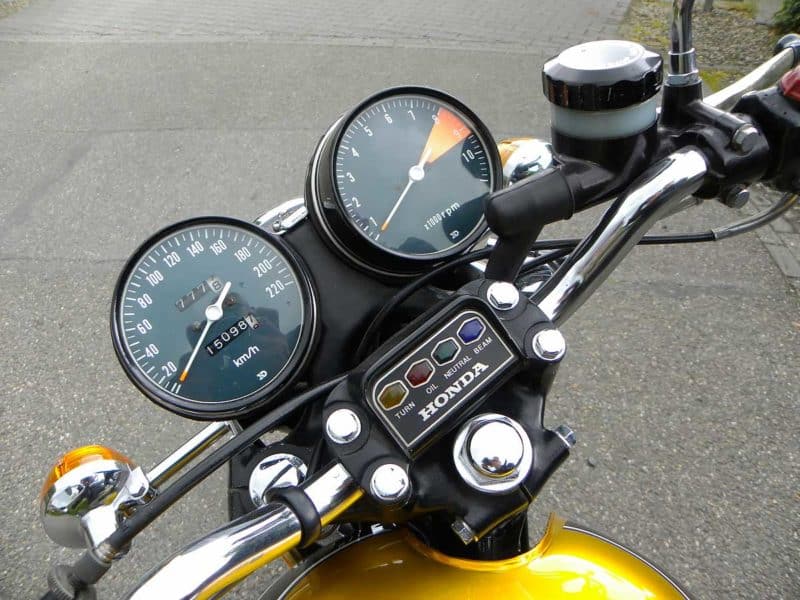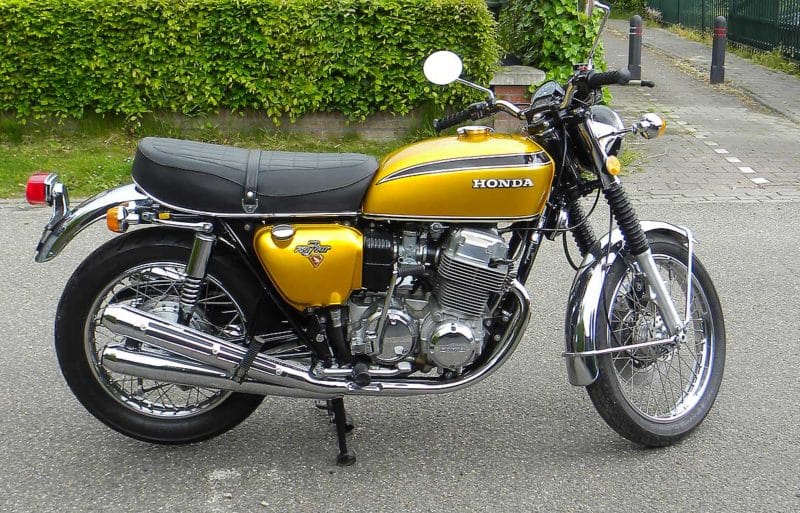The Honda CB 750, also known as the "motorcycle of the (last) century", was the first really strong, fast and reliable heavy motorcycle. It was a groundbreaking vehicle that dealt a final blow to the British motor industry. With its iconic status, the CB 750 became a benchmark for generations of motorcyclists and remains a legend to this day.
The Honda CB 750. A timeless classic
Introduced in 750 and still loved today, the Honda CB 1969 F is not only an iconic motorcycle, but also one of the most usable and stylish classics. Even today this bike can leave many a fellow rider behind, especially if you optimize the front and rear suspension (Hyperpro!) and fit modern tires. With its beautiful design, sufficient speed and good handling, the CB 750 remains a motorcycle to be reckoned with.
Tips for purchasing and restoring a Honda CB 750
If you are considering purchasing a Honda CB 750, it is advisable to look for one that is as original and complete as possible. Restoring a classic Japanese motorcycle is often easy to do nowadays, thanks to suppliers such as global mail order company CMSNL.com and other specialists. However, keep in mind that prices for new parts for old Japanese engines tend to be high, especially for color and chrome parts. For example, a complete set of exhausts can quickly cost more than € 2.000. Spraying the characteristic candy colors is also not for everyone and can cost a lot of money. In addition, it is important to order parts based on the frame number / block number, because adjustments and changes have been made over time that make the difference between an "original year" and a "non-original year". Ordering by number is especially useful for technical adjustments.
Technical aspects and points of attention
In the early years of the Honda CB 750, there were motorcyclists who revved their engines to maximum rpm on campsites, causing misfiring and exhaust noise that sounded like a firing squad on a national holiday. Despite these practices, the engines remained intact. A concern, however, was that the camshaft lubrication nozzles could become clogged when using aftermarket oil filters and flexible service intervals. This could lead to a broken crankshaft, which suddenly turned the CB 750 into a two-cylinder with half the displacement.
Early models of the Honda CB 750 had sand cast crankcases, of which several thousand units are estimated to have been made. These copies are rarer and therefore more expensive. With early models it is also important to check that the crankcase at the height of the rear sprocket is in good condition, because in those days the chain sometimes broke under the raw power of the engine. The most common and practical models are the candy yellow K2 (and K3) models. When ordering parts, it is essential to state the year, number and type of the motorcycle, as quite a few (minor) changes have been made during the production period.
Maintenance and adjustments
Maintenance on the Honda CB 750 is generally easy. However, synchronizing the carburetors requires a vacuum gauge, as absolute hearing is no longer sufficient. Although it differs from the original design, the purchase of an electronic ignition can be very useful.
Technical specifications Honda CB 750 Four (1969):
- Type: Air-cooled, four-stroke in-line four-cylinder
- Cylinder capacity: 736cc
- Maximum power: 67 hp @ 8000 rpm
- Gearbox: five-speed
- Secondary transmission: chain
- Frame: double cradle frame
- Brakes: front disc brake, rear simplex drum brake
- Weight: 218 kg
- Top speed: approx. 180 km/h
Price indication: For a nice example from the first half of the 70s, the price usually varies between € 8.000 and € 12.000. However, there are also cases where an asking price of € 13.500 or higher has been seen.






I've seen that engine before.. it's even on: http://www.gp-classics.be/
But the photo on that website was taken by the person who refurbished the bike, namely Mr. Stoffele in Ven-Zelderheide who used to have the name GP Classics.
That's funny and educational. It was here in the CB folder of classics that I had made at Gallery Aaldering. Why not visit Ven Zelderheide! Thanks for the tip
Had a CB750 Four F! from 1977 yellow with great pleasure ridden with my then girlfriend now my wife made many tour trips, had more than 28 years then gravity on the wrists came through the Rickman fairing and that was not to my liking. Then bought a Yamaha XJ 700 S, on which I could sit upright because of my back from 1985, now 11 years old.
And just keep going!
Bought a brand new suzuki 1973gt in 750 you made the man there we had 4 in the group, each a different color, they still talk a lot about the wonderful time
Cherish your memories!
Hello Dolf
A nice article about an even nicer engine. I am also the lucky owner of a Candy gold CB 750 K2 from 1975. Bought second hand in 2. It now has over 1979 km on it. This is after having the piston rings and internal chains replaced at over a ton. But the device just always works .. And indeed, what they used to do with it ... then you don't have much sense, or you've had too much beer...
Thanks Dolf for your explanation. IN attachment again the engine that still works, is even used for accompanying motorcycles and old-timers, after so many years of service and with at least 300.000 km on the clock. Not without restoration of course, the last one dates from just before corona, with the renewal of the internal parts.
Getting old is easy. Aging gracefully requires some extra attention. Nice engine!
A classic beauty!
As a 10-year-old in the mid-70s, I went with my dad to Bakker motors at the Burcht in Zaandam to take a look at motors. The gold Honda CB 750 made an unforgettable impression on me then…and still does. Been driving a BMW R 90/6 from 1976 for a while now, spotted in another shop window as a kid at the time, but this Honda is still on my 'bucket list'
Congratulations on your good taste. Unfortunately, the time when you had a neat K2 for 2500 guilders is over
Well the 1st reliable bike, the BMW R75/5 did and still does not go wrong. Of course it is a completely different engine, but also very solid and reliable.
They were the top of their time, anyway
There are those moments that always stay with you:
It must also have been in 1969 or in that neighborhood that I was looking at the Piet van Dijk motorcycle shop in Enschede with my Sparta moped and saw not only the first CB750 of my life but also the 1200 cc Friedel Münch engine with 4 cylinder NSU block. Seeing those 2 motorcycles together was really unique, at least for me.
We share the same postive trauma!
I bought my first motorcycle in 1977 from Piet van Dijk in Enschede, then saw the Honda CB 750 Four years ago in the Kuipersdijk, mighty beautiful machine, still is, by the way, Kawasaki Z900, Yamaha XS1100 are those unforgettable motorcycles
"In the early days of the Honda CB 750, there were motorcyclists who would rev their engines to maximum revs at campsites, causing misfiring and making the exhaust sound like a firing squad on a national holiday."
Was a local folklore the Friday night before the TT.
Heaps of guys with way too much beer in them and rattling 4 cylinders over all campsites.
Very occasionally one spontaneously fell out, after which a deafening cheer sounded.
Then there was one with a leg out or something…
Someone could hitchhike home...
After borrowing my brother's Suzuki GT 750 for a while (fantastic 3 cylinder 750cc 2 stroke), I bought a CB750F2 with the Comstar wheels. 2nd Hand and I think bought in 1981 or something. Really nice bike, went to the North Cape (low sports steering wheel temporarily replaced by half-high steering wheel). The only problem then was that the floats sometimes got stuck, so at the campsite then take off the carbs and clean them. Otherwise fine, but later somewhere in Luxembourg suddenly huge speed wobble etc. Replaced all bearings etc., but remained mediocre.
After that I had all kinds of other fast bikes and also went to Scandinavia with a number of them (last time with Aprilia 1000R from 2006 at the North Cape, still my current bike). But the Honda was fun until the problems came. Maybe a crack in the chassis.
Although the 750 was and is the 'benchmark', the small versions in particular were much more manageable and usable.
The 500F and 350F, despite lower weight and top speed, were also fantastically usable bikes from the same family branch.
Finally a block that easily did a ton or a half with fingers in the nose without major revisions.
It is not for nothing that so many lighter four-cylinders have been sold
in my time at Honda NL we had more of these steering problems, which in almost all cases were caused by the bearings of the steering head, have in regards. advised to use conical bearings that you could adjust, which usually solved the problems, ps the speed wobble may have been the cause of frame cracks!
Years ago I also had such a 'speed wobble' with my BMW R45/…65… At a more precisely measured 127 km/h it was well and firmly hit. Something to literally stay dead with, he went on. Terrifying even. Cause not found. The headset has tapered bearings and no matter how you pulled or yanked it, not an ounce of play felt. Finally tightened the steering head until the point was reached where it started to steer nauseously. Set back slightly so that he sent out the great art again. The 'speed wobble' was gone and stayed away. With the progressive springs from Hyperpro at the front and complete shock absorbers with progressive springs from IKON at the rear, it rides extremely stable. Like on rails. The preload on the headset bearings was key to eliminating the speed wobble.
That's gold. Headset bearings are often the neglected children
Noted!
So that crack could be. And you can always buy another one!
That's the time when you drove much better with 10 beers in your aim. Now we have become Spa and buttermilk drinkers. Wisdom comes with age or something?